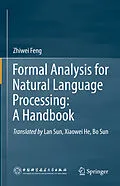The field of natural language processing (NLP) is one of the most important and useful application areas of artificial intelligence. NLP is now rapidly evolving, as new methods and toolsets converge with an ever-expanding wealth of available data. This state-of-the-art handbook addresses all aspects of formal analysis for natural language processing. Following a review of the field's history, it systematically introduces readers to the rule-based model, statistical model, neural network model, and pre-training model in natural language processing.
At a time characterized by the steady and vigorous growth of natural language processing, this handbook provides a highly accessible introduction and much-needed reference guide to both the theory and method of NLP. It can be used for individual study, as the textbook for courses on natural language processing or computational linguistics, or as a supplement to courses on artificial intelligence, and offers a valuable asset for researchers, practitioners, lecturers, graduate and undergraduate students alike.
Autorentext
Feng Zhiwei is a computational linguist and senior research fellow at the Institute of Applied Linguistics, Ministry of Education, China. He has a broad and extensive background in linguistics, mathematics and computer science, and has been engaged in interdisciplinary research in linguistics, mathematics and computer science for more than 50 years. One of the first natural language processing and computational linguistics scholars in China, he has published more than 30 books and more than 400 papers in China and abroad. He is the winner of the NLPCC (Natural Language Processing & Chinese Computing) Distinguished Achievement Award of the CCF (China Computer Federation) in 2018.
Inhalt
Part One History Review
Chapter One
Past and Present of Natural Language Processing
1.1 What is natural language processing
1.2 History review of natural language processing
1.3 Characteristics of current trends in natural language processing
References
Chapter Two
Pioneers in the Study of Language Computing
2.1 Markov chains
2.2 Zipf's law
2.3 Shannon's work on entropy
2.4 Bar-Hillel's category grammar
2.5 Harris's approach of linguistic string analysis
2.6 . . 's linguistic set theory model
References
Part Two Formal Models
Chapter Three
Formal Models Based on Phrase Structure Grammar
3.1 Chomsky's hierarchy of grammar
3.2 Finite-state grammar and its limitations3.3 Phrase structure grammar
3.4 Recursive transition networks and augmented transition networks
3.5 Bottom-up and top-down analysis
3.6 General syntactic processor and chart parsing
3.7 Earley algorithm
3.8 Left corner analysis
3.9 Cocke-Younger-Kasami algorithm
3.10 Tomita algorithm
3.11 Government and binding theory and minimalist program
3.12 Joshi's tree-adjoining grammar
3.13 Formal description of the structure of Chinese characters
3.14 Hausser's left-associative grammar
References
Chapter Four
Formal Models Based on Unification
4.1 Multiple branched and multiple labeled tree analysis (MMT)
4.2 Kaplan's lexical functional grammar
4.3 Martin Kay's functional unification grammar
4.4 Gazdar's generalized phrase structure grammar
4.5 Shieber's PATR
4.6 Pollard's head-driven phrase structure grammar
4.7 Pereira &Warren's definite clause grammar
References
Chapter Five
Formal Models Based on Dependency and Valence
5.1 Origin of valence
5.2 Tesnière's dependency grammar
5.3 Application of dependency grammar in natural language processing
5.4 Valence grammar
5.5 Application of valence grammar in natural language processing
References
Chapter Six
Formal Models Based on Lexicalism
6.1 Gross' lexicon-grammar
6.2 Chain grammar
6.3 Lexical semantics
6.4 Ontology
6.5 WordNet
6.6 HowNet
6.7 Pustejovesky's generative lexicon theory
References
Chapter Seven
Formal Models of Automatic Semantic Processing
7.1 Sememe analysis
7.2 Semantic field
7.3 Semantic network
7.4 Montague's semantics
7.5 Wilks' preference semantics
7.6 Schank's conceptual dependency theory
7.7 Mel'chuk's meaning-text theory
7.8 Fillmore's deep case and frame semantics
7.9 Word sense disambiguation methods
References
Chapter Eight
Formal Models of Automatic Situation and Pragmatic Processing
8.1 Basic concepts of systemic functional grammar
8.2 Application of systemic functional grammar in natural language processing
8.3 Speech act theory and conversation intelligent agent
References
Chapter Nine
Formal models of Discourse Analysis9.1 Reference resolution
9.2 Reasoning techniques in text coherence
9.3 Mann & Thompson's rhetorical structure theory
References
Chapter Ten
Formal Models of Probabilistic Grammar
10.1 Probabilistic context-free grammar and sentence ambiguity
10.2 Fundamentals of probabilistic context-free grammar10.3 Three assumptions of probabilistic context-free grammar
10.4 Probabilistic lexicalized context-free grammar
References
Chapter Eleven
Formal Models of Neural Network and Deep Learning11.1 Development of neural network
11.2 Brain neural network and artificial neural network
11.3 Machine learning and deep learning11.4 Word vector and word embedding (CBOW, Skip-gram)
11.5 Dense word vector (Word2vec)
11.6 Perceptron
11.7 Feed-forward Neural Network (FNN)11.8 Convolutional Neural Network (CNN)
11.9 Recurrent Neural Network (RNN)
11.10 Attention mechanism
11.11 External memory
11.12 Pre-training models (Transformer and BERT)
References
Chapter Twelve
Knowledge Graph
12.1 Knowledge graph and deep learning
12.2 Knowledge representation
12.3 Entity recognition
12.4 Entity disambiguation
12.5 Relation abstraction
12.6 Entity abstraction
12.7 Knowledge storage
12.8 Knowledge inferenceReferences
Conclusion
